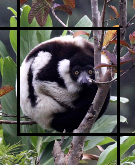One of the glacial erratics found on top of Steamboat Rock.
What impresses me about Washington state is its extreme diversity. While it doesn’t quite hit the heights of biodiversity of California, it certainly gives it a good challenge!
From the coastal wilderness of the Olympic Peninsula, the mountainous interior of the Olympics and the Cascades to the vast steppe regions of the rain shadow areas of central Washington to the amazing desert-like landscape of the Coulee Basin, Washington is an amazing place.
In 2007, Som, Cokie and I took an extended spring break trip (two weeks) exploring this region. We started our camping expedition in Swakane Canyon searching for the elusive Bighorn Sheep. After driving several miles down a dirt track, we came across a spectacular herd of female sheep grazing on the mountainside. We spent hours hiking the hills, spending time with the sheep and Black-tailed Deer that were very numerous as well in the canyon. We also had some close views of Yellow-bellied Marmots playing in the rock outcroppings of the Swakane. And on the way out of the Canyon we spotted a herd of male sheep grazing along the roadside. Spectacular!
The next few days were spent camping at the base of Steamboat Rock, in the heart of the Coulee Basin. Prior to this trip, I had been doing quite a lot of research on the great Missoula Flood that carved the spectacular canyons that exist in this part of the state. Reading Bretz’s Flood exposed me to an amazing story of science, geology and discovery. The region that Harlin Bretz loved and studied fascinated me as well. In fact, the entire expedition during these two weeks had a dual theme – finding wildlife (of course!) and tracing the steps of this great scientist and exploring the regions carved by the Missoula Flood. The sheer cliffs surrounding the Steamboat Rock area were the result of these massive floods.
We spent days trekking the flower-filled steppe grasslands and glacial erratics-filled mesa of Steamboat Rock and Northrup Canyon. Although it was spring, the winter was still in full force. A simple ten-mile trek in to Northrup Canyon involved warm sun breaks and blinding blizzards! The climatic shifts were spectacular albeit somewhat difficult to cope with. We explored the caverns and canyons created by the Missoula Floods - basically retracing Bretz’s footsteps.
Gradually we worked our way down to Potholes State Park and the Columbia Basin National Wildlife Refuge. Here we did some fantastic birding and wildlife viewing. Hiking the wetlands of Columbia Basin allowed us great sightings of North American Beavers, Red Squirrels and many other species. The massive flocks of Canada geese and other waterfowl are tough to match anywhere in the US these days.
The expedition continued down the Columbia River Gorge after a stop near Yakima for some world class baklava at an orthodox Greek village we found cruising the mountains just to the southwest of town. What the hell they were doing there I have no idea, but the baklava was outstanding! The Gorge was spectacular with the fresh spring foliage sprouting from the maples along the river. We stopped at numerous sites and enjoyed the Gorge before heading further south to Sweet Home, Oregon for a quick family visit.
While in Sweet Home, we were able to spend some time trekking spectacular Silver Falls State Park. Still home to some wonderful forest and some amazing waterfalls, Silver Falls is basically an island of forest completely surrounded by clear cuts and farmlands. But at least it gives you a glimpse of what used to be.
On the way back to Port Angeles, we spent a few days working our way back up the Columbia River, stopping at wildlife refuges searching for more nature. The region is replete with nature spots, but searching for the Columbian White-tailed Deer at the refuge set aside for them was one of the high points. Although we failed to see them, we did get some great sightings of many other species of mammals and birds.
We had time for one more kayaking trip while on the expedition. We spent a day kayaking over to Long Island in Wallapa Bay near the Pacific coast of Washington. The trip is a simple quarter mile trip across a narrow inlet to an uninhabited island that is home to some of the oldest western red cedars anywhere in the state. It was becoming late in the day so we had to trek at a brisk pace, but the five mile hike was well worth it. The trees were spectacular! But by the time we came back, the winds shifted and the kayak ride back to the mainland was a bit tough. We were all pretty soaked, but what a great way to conclude our adventure through Washington!
Please take a look at our North America Image Galleries!
Eastern Washington Landscapes Image Gallery
Take a look at some of the images below to get a sense of what we experienced on our expedition!
